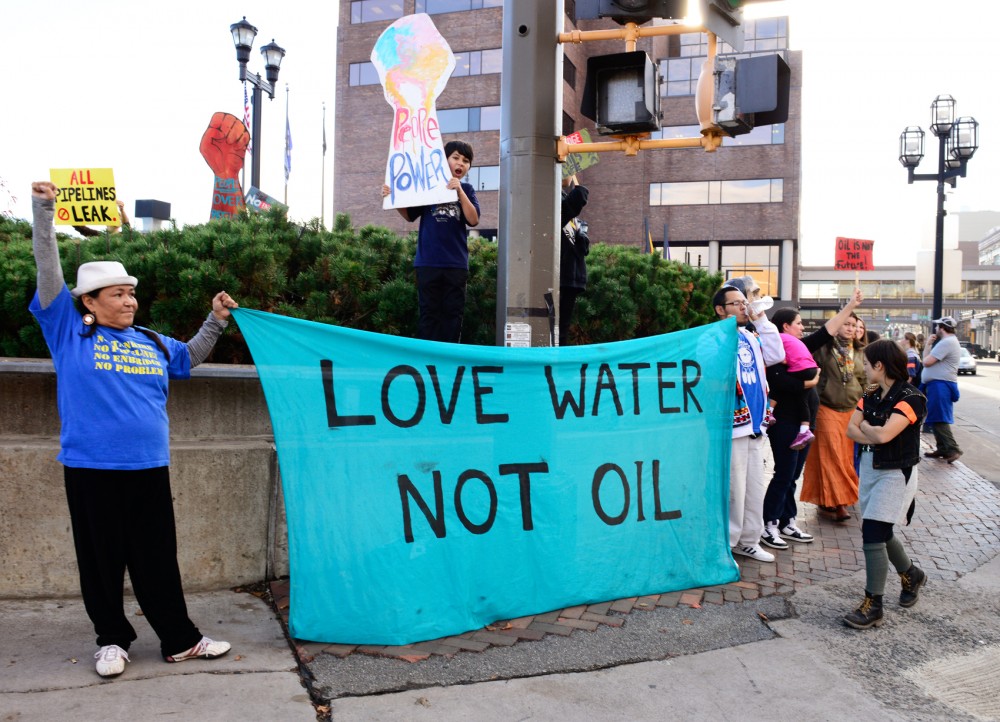A600-mile pipeline could eventually haul crude oil across a stretch of northern Minnesota, near the Mississippi River’s source.
Concerned that the controversial project could threaten area bodies of water, a bus full of University of Minnesota students trekked to Duluth Monday to join hundreds of other protesters.
Some University students and environmental groups say that plans by Enbridge, a Canada-based oil company, to install a series of pipelines could endanger Mississippi headwaters, Minnesota’s lake country and area University research.
More than 200 people protested Enbridge Monday, said Mahyar Sorour, Minnesota Public Interest Research Group’s campus organizer for Hamline University and St. Catherine University.
Six of the many demonstrators who filled Enbridge’s office and sat-in for a few hours were arrested, Sorour said.
People from the Twin Cities, Duluth and members of the Fond du Lac Band of Lake Superior Chippewa attended the protest to voice their concerns about the proposed project’s impact on water quality.
Before the rally, the Minneapolis American Indian Center hosted a climate conference from Friday to Sunday, which brought together students from across the Midwest to discuss fossil fuels and pipeline projects.
Richard Smith, president of Friends of the Headwaters, a local citizen’s group based in Park Rapids, said Ojibwe tribes are concerned that the Sandpiper pipeline goes through their most important wild rice waters.
The 600-mile pipeline would travel through northern Minnesota and transport crude oil from western North Dakota to a terminal in Superior, Wis.
James Cotner, an ecology, evolution and behavior professor has been researching lakes and other freshwater ecosystems near the proposed pipelines at the University’s biological station and laboratory in Itasca State Park for the past 13 years.
Many undergraduate and graduate students come to research the surrounding lakes as part of biology courses, he said.
The pipelines are not quite close enough to directly affect the work in the park, Cotner said, but they could impact the area in general.
“They couldn’t have picked a worse place, from my perspective, to have it go,” he said.
Surrounding ponds and the Mississippi River are closer to the proposed project site and would be more at risk, he said.
Cotner said the biggest concern would be leakages, which are not unlikely with the types of infrastructures Enbridge is proposing, pointing to a 2010 oil spill in Kalamazoo, Mich., from an Enbridge pipeline.
Enbridge already received the permits needed to begin work in North Dakota, but they are still working through the regulatory process in Minnesota, Enbridge spokeswoman Lorraine Little said.
The Minnesota Public Utilities Commission granted the company one of two permits it needs to build the pipeline, but in September, the Minnesota Court of Appeals ruled it should not have been issued without a full environmental study, Little said.
Richard Smith, president of Friends of the Headwaters, said in an email that Enbridge and the Department of Commerce agreed to complete an environmental impact statement Friday, which would determine the effects the Sandpiper pipeline would have.
“Protecting the environment and people who live and work along our pipeline system is our top priority,” Little said. “We spend a lot of money making sure our pipeline system is operating safely.”
She said more than 20 adjustments have been made to ensure the most efficient and safe route, and the route was made to follow existing pipeline routes.
Enbridge transports 2 million barrels of crude oil per day, she said.
The Department of Commerce received about 650 comments from the public about the project.
Smith said the group proposed another route for the pipeline through southwestern Minnesota.
“There isn’t a safe alternative for Minnesota’s lake country,” Smith said.


